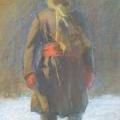 Born in Arthabaska (now a part of Victoriaville) in 1869, Marc-Aurèle de Foy Suzor-Coté is one of Quebec's most celebrated artists. The youngest of ten children, Suzor-Coté studied art in Montreal and Paris. He began his art career as a church decorator with the firm of Joseph-Thomas Rousseau. It was through his uncle Monseigneur Philippe-Hippolyte Suzor, the parish priest of Saint-Christophe-d'Arthabaska, that Suzor-Coté was hired by Rousseau to work on that church's interior. However, it was as a painter (in both oils and pastels), and later as a sculptor, that Suzor-Coté made a name for himself.
Born in Arthabaska (now a part of Victoriaville) in 1869, Marc-Aurèle de Foy Suzor-Coté is one of Quebec's most celebrated artists. The youngest of ten children, Suzor-Coté studied art in Montreal and Paris. He began his art career as a church decorator with the firm of Joseph-Thomas Rousseau. It was through his uncle Monseigneur Philippe-Hippolyte Suzor, the parish priest of Saint-Christophe-d'Arthabaska, that Suzor-Coté was hired by Rousseau to work on that church's interior. However, it was as a painter (in both oils and pastels), and later as a sculptor, that Suzor-Coté made a name for himself.
Inevitably, Suzor-Coté met Arthabaska's most notable resident, Sir Wilfrid Laurier, who was Leader of the Liberal Party and (for much of Suzor-Coté's career) Prime Minister of Canada. Laurier would award the young artist with a number of important commissions, and no doubt the favour of such a prominent patron helped his career considerably. Suzor-Coté was friends with another famous Townships artist, sculptor Alfred Laliberté, who was born in nearby Sainte-Élisabeth-de-Warwick. The two met in Paris.
 Suzor-Coté travelled extensively in the 1890s and early 1900s in Canada, Europe, and the United States. He first attracted attention in exhibitions organized by the Art Association of Montreal. His studies and apprenticeship in Paris prepared him for a successful career in Canada in portrait painting, landscapes, and still life. By about 1910, Suzor-Coté was firmly established as one of Canada's pre-eminent artists. He divided his time between his studios in Montreal and Arthabaska. He became a member of the Royal Canadian Academy of Arts (RCA) in 1914 and the Sculptor's Society of Canada (SSC) in 1929.
Suzor-Coté travelled extensively in the 1890s and early 1900s in Canada, Europe, and the United States. He first attracted attention in exhibitions organized by the Art Association of Montreal. His studies and apprenticeship in Paris prepared him for a successful career in Canada in portrait painting, landscapes, and still life. By about 1910, Suzor-Coté was firmly established as one of Canada's pre-eminent artists. He divided his time between his studios in Montreal and Arthabaska. He became a member of the Royal Canadian Academy of Arts (RCA) in 1914 and the Sculptor's Society of Canada (SSC) in 1929.
Suzor-Coté is perhaps best known for his depictions of the simple country life and the people he encountered in his native Arthabaska, which he loved until the day he died. In 1927, he became paralysed and was no longer able to paint or sculpt. He died in Florida in 1937 and is buried in Arthabaska.
Suzor-Coté's works can be found in museums and private collections across Canada. The Laurier Museum in Arthabaska has a number of his works in its collection.